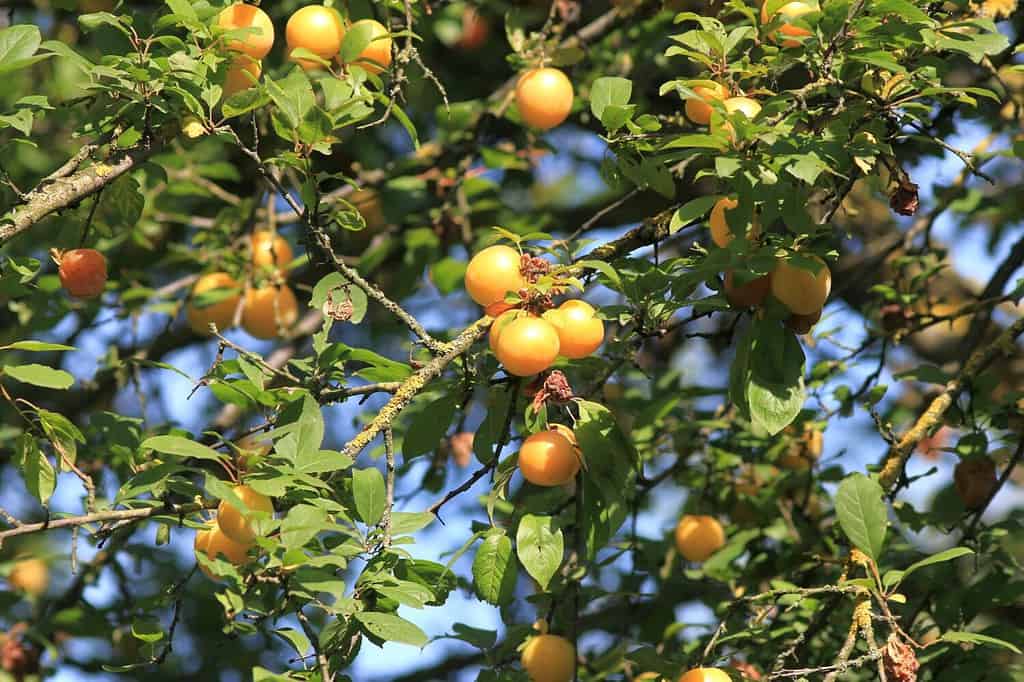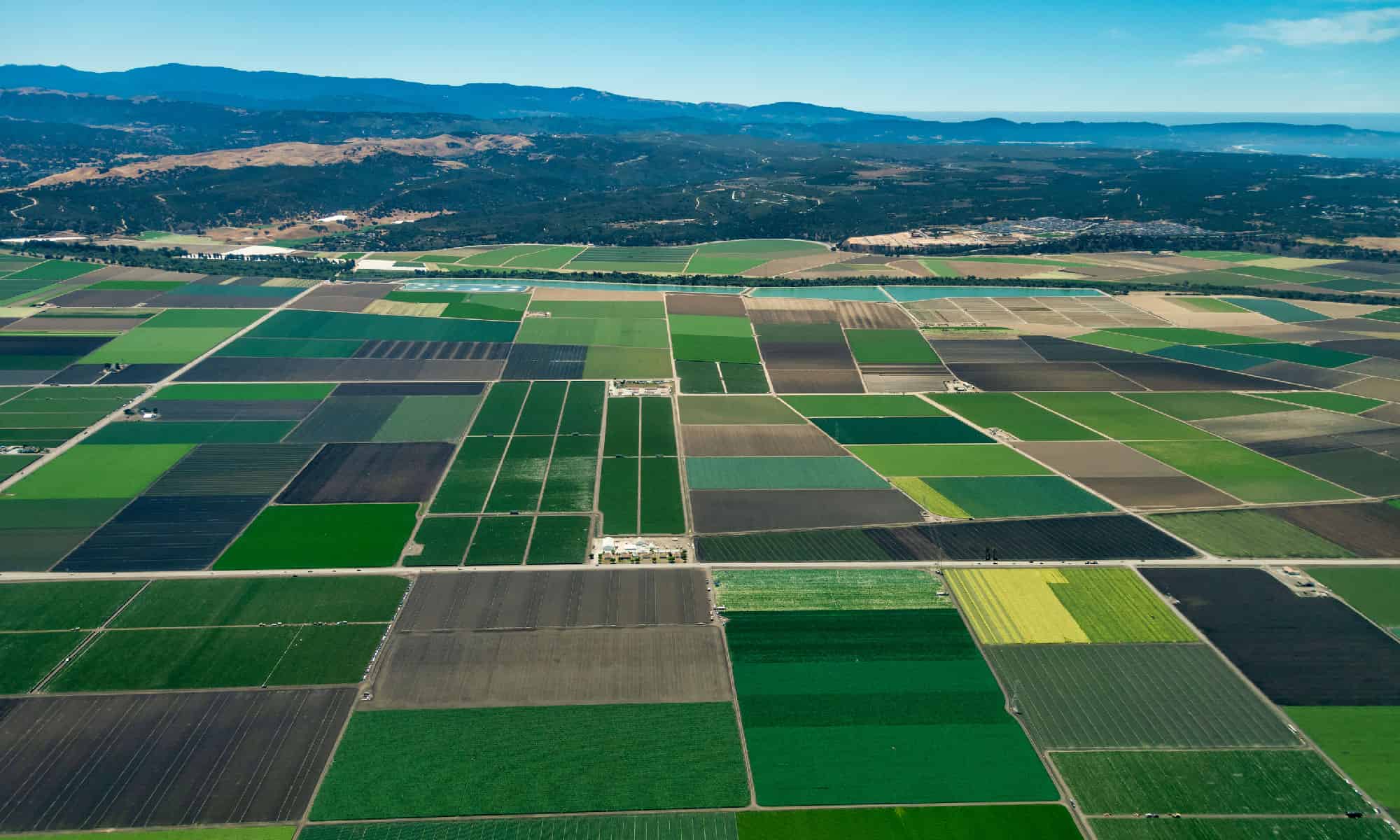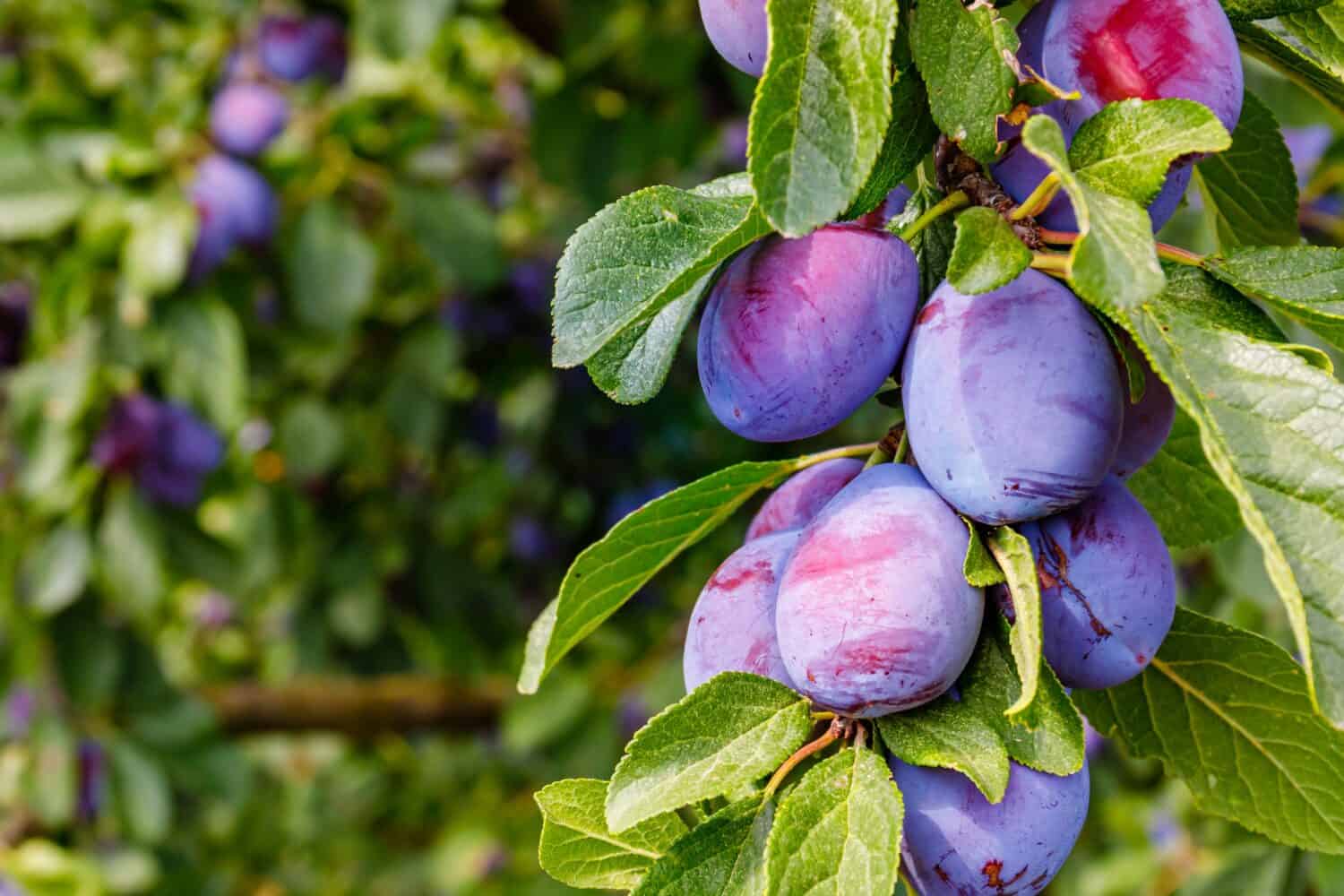Plump, juicy, and bursting with sweetness, plums have an enchanting allure that captivates fruit lovers across the United States. As the sun warms the land and the days stretch long, these delectable fruits reach their pinnacle of perfection during peak season. A symphony of colors, from rich purples to vibrant yellows and soft greens, adorns orchards from coast to coast.
Plum enthusiasts eagerly anticipate the arrival of this seasonal delight, which typically spans from late spring to early autumn. Orchards in California kick off the season, providing an abundant harvest in May, while other states like Georgia, Oregon, and Michigan join the fruit fiesta throughout the summer months. The peak of plum perfection varies slightly depending on the region, but its arrival is always met with joy and anticipation.
In this article, we’ll explore when plums are in season across the United States! But first, let’s break down what a plum actually is for those unfamiliar with the fruit.
What are Plums?
Plum, a delectable and juicy fruit, belongs to the botanical classification of the genus Prunus, within the family Rosaceae. It is a widely loved fruit for its sweet and tangy flavor, vibrant colors, and various culinary applications.
Physical Description
Plums are small to medium-sized fruits with smooth, thin skin that ranges in color from deep purple and red to yellow and green. The fruit’s flesh is succulent and can be either yellow, red, or purple, depending on the variety. The center of the plum contains a single hard stone-like pit, which is surrounded by edible flesh.
Botanical Classification
Plums belong to the Prunus genus, making them a member of the Rosaceae family, which includes other fruits like cherries, apricots, and peaches. There are several species and cultivars of plums, each with its distinct characteristics, but all share common attributes such as the round shape and stone pit in the center.
Cultivation and Habitat
Plum trees do very well in temperate climates and are cultivated in many regions worldwide. They require well-drained soil and plenty of sunlight to grow and produce an abundant harvest. Plum trees bloom with fragrant flowers in the spring, which later develop into luscious fruit during the summer months.
Culinary Uses
Plums are highly versatile in the culinary world. They can be enjoyed fresh as a delicious snack or used in various recipes for jams, jellies, pies, tarts, and desserts. Also, dried plums, commonly known as prunes, are popular for their natural sweetness and health benefits.
Health Benefits
Besides their delightful taste, plums offer several health benefits. They are rich in vitamins, minerals, and dietary fiber, promoting digestive health and supporting the immune system. Plums also contain antioxidants, which help combat free radicals and contribute to overall well-being.
Now that we know what plums are, let’s just right into when they are in peak season across the United States.

Plums come in many shapes and colors, such as the yellow cherry plum (pictured).
©Dina Rogatnykh/Shutterstock.com
When Plums are in Season Across the United States
The peak season for plums varies across different regions of the United States, as climate and geography influence the fruit’s growth and ripening patterns. Let’s explore when plums are in their prime in various parts of the country.
West Coast
On the West Coast, specifically in California, plums begin to ripen in early summer, typically around May or June. The temperate climate and ample sunshine in this region create favorable conditions for plum trees to flourish. Varieties like Santa Rosa, Burgundy, and Black Amber are some of the first to arrive on the scene, filling local markets with their juicy goodness. Farmers and orchard owners diligently monitor the fruit’s progress, waiting for the perfect balance of sweetness and texture before harvesting.
Pacific Northwest
Moving up the coast to the Pacific Northwest, plum season hits its stride during midsummer, around July and August. Washington and Oregon are prominent plum producers in this region, boasting an array of cultivars such as Italian, Stanley, and Brooks. As the days grow longer and the temperatures warm up, these plums flourish, displaying their ripe and succulent fruits. Consumers eagerly flock to farmers’ markets and grocery stores to savor the mouthwatering taste of locally grown plums.
Southwest and Mountain States
In the Southwest and Mountain States, plum season arrives in full force during late summer, typically in August and September. States like Arizona, New Mexico, and Colorado enjoy the bounty of plums from local orchards. Varieties like Methley, Shiro, and Ozark Premier take center stage during this time, offering a spectrum of flavors and colors. As the summer heat persists, the plums reach their peak ripeness, making them ideal for fresh consumption or transforming into delightful preserves and baked goods.
Midwest
Heading to the Midwest, the plum season makes a transition from summer to early fall, spanning from August to September. States like Michigan, Wisconsin, and Illinois witness the arrival of plum varieties like Empress, Toka, and Pipestone. The moderate temperatures in this region provide an optimal environment for plum trees, allowing the fruits to mature gracefully. Farmers and orchardists gear up for the harvest, ready to supply the market with an abundance of these juicy gems.
Northeast and East Coast
As the summer wanes and autumn approaches, the Northeast and East Coast experience their plum season, which typically runs from late August to October. States like New York, Pennsylvania, and Massachusetts boast a selection of plum varieties such as Bluebyrd, President, and Early Italian. Cooler temperatures and shorter days lend a unique character to these plums, enhancing their sweetness and developing their unique flavors. People relish the opportunity to indulge in the last of the season’s plum offerings before winter sets in.
What Region of the U.S. is Known for Growing Lots of Plums?
When it comes to plum production in the United States, one region stands out as the unrivaled leader: California. With its unique combination of favorable climate, rich soil, and extensive agricultural expertise, California has established itself as the top plum-growing state in the nation.

California is known for its excellent farmland and plum crops.
©Dreamframer/Shutterstock.com
Climate Advantage
California’s diverse microclimates provide the perfect setting for plum cultivation. In the San Joaquin Valley, which stretches through the heart of the state, warm summers and mild winters create an ideal environment for plum trees to thrive. The Mediterranean climate with its long, hot, and dry summers ensures that plums receive ample sunlight and heat to ripen to perfection. Moreover, the cooler temperatures during the winter provide the necessary chill hours required for proper dormancy, essential for plum trees to produce a bountiful harvest.
Rich Soil and Irrigation
The fertile soils found in many regions of California contribute significantly to the success of plum cultivation. The alluvial soils in the San Joaquin Valley, for instance, are enriched by sediments deposited by rivers over time, offering a wealth of nutrients essential for plant growth. Just as well, the state’s well-developed irrigation infrastructure, utilizing water from rivers and reservoirs, ensures a reliable water supply for plum orchards even during dry spells, fostering healthy tree growth and abundant fruit yields.
Experience and Expertise
California’s extensive agricultural experience plays a pivotal role in the state’s plum production. Over the years, growers in California have honed their skills and knowledge in managing plum orchards, employing advanced farming techniques to optimize yields and fruit quality. Also, the state’s agricultural universities and research institutions continually study and develop improved plum varieties that are well-suited to California’s climate and soil conditions, further boosting the industry’s success.
Infrastructure and Market Access
California’s well-established agricultural infrastructure, including transportation networks and storage facilities, facilitates the efficient harvest and distribution of plums. The state’s proximity to major markets and ports also ensures quick and convenient access to consumers both domestically and internationally, enhancing the economic viability of plum production in California.
Can Any Hardiness Zone Not Grow Plums in the U.S.?
Hardiness zones are a crucial tool for gardeners and farmers, indicating the minimum temperatures a specific region experiences during winter. These zones help determine the suitability of growing various plants, including plums. However, there are some zones that cannot sustain the growth of plums.
Plum Hardiness Zones
Plums generally thrive in USDA hardiness zones four to nine. In these zones, plum trees can withstand winter temperatures and produce a healthy crop during the growing season.
The Limitation of Zone Three
The coldest hardiness zone in the contiguous United States is zone three, which experiences extremely cold winters with minimum temperatures dropping to -30 to -40 degrees Fahrenheit. Plum trees are not well-suited to survive such frigid conditions. In zone three, the winter cold can damage the plum tree’s branches, buds, and roots, hindering its ability to bear fruit in the subsequent growing season.
While growing plum trees in zone three can be challenging, some gardeners have experimented with hardy plum varieties that can tolerate colder temperatures. These varieties, often referred to as “cold-hardy” plums, have been selectively bred to withstand the harsh conditions of zone three. However, even with these hardy varieties, success may still be uncertain, and additional protection, such as winter mulching and windbreaks, is often necessary to improve the chances of survival.
Where to Go Pick Plums in the U.S.
Across the United States, numerous orchards and farms offer the delightful experience of picking fresh plums straight from the trees. Many states with favorable growing conditions, such as California, Oregon, Washington, Michigan, and New York, boast a variety of plum orchards that welcome visitors during the harvest season.
U-Pick farms are popular destinations for fruit enthusiasts looking to engage in hands-on harvesting. These farms allow visitors to pick their own plums directly from the orchards. It’s a fun activity for families and individuals to connect with nature and savor the taste of freshly picked fruit.
Farmers’ markets in various cities and towns often feature local plum growers selling their fresh produce. While you may not be picking the plums yourself, you can still support local farmers and find a wide selection of plum varieties to choose from.
Some regions celebrate the plum harvest with community events and festivals, where visitors can enjoy not only picking plums but also participate in activities like tastings, cooking demonstrations, and entertainment.
How to Grow Your Own Plums at Home
Growing plums at home can be a rewarding and enjoyable experience! These delectable fruits, packed with sweetness and nutrients, thrive under the right conditions. Whether you’re an experienced gardener or a beginner, these tips will guide you in successfully cultivating plum trees in your own backyard.
1. Choose the Right Variety
Selecting the appropriate plum variety for your region is crucial for successful growth. Consider the local climate, hardiness zone, and chill hours required by the plum tree. Common cultivars like Santa Rosa, Methley, and Stanley are suitable for many regions, while cold-hardy varieties may be necessary for colder climates.
2. Find the Ideal Location
Plum trees flourish in areas with full sun exposure. Choose a good spot in your garden or yard that can get at least six to eight hours of direct, hot sunlight each day. A decent amount of sunlight ensures robust growth, flower development, and fruit ripening.

Growing your own plums at home is very easy, but keep in mind that their pits can be a choking hazard for animals and small children.
©Elena Sherengovskaya/Shutterstock.com
3. Provide Well-Drained Soil
Plum trees prefer well-drained soil with a pH level of 6.0 to 7.5. Soil that retains excess water can lead to root rot and other diseases. If your soil doesn’t naturally drain well, consider raised beds or planting on slopes to prevent waterlogged conditions.
4. Plan for Adequate Space
Plum trees require sufficient space for healthy growth and proper airflow. Allow at least 15 to 20 feet of space between trees to prevent overcrowding and enhance pollination.
5. Implement Proper Pollination
Plums are not entirely self-pollinating, so it’s essential to plant multiple varieties or have a compatible plum tree nearby for cross-pollination. This ensures better fruit set and higher yields.
6. Pruning for Optimal Growth
Regular pruning is vital for maintaining plum trees’ shape, health, and productivity. Prune during the dormant winter months to remove dead or diseased branches, improve airflow, and stimulate new growth. Just as well, thinning the fruits during the growing season promotes larger and healthier plums.
7. Watering Needs
Proper watering is very important, especially during the first few years of a plum tree’s life. Young trees need regular watering to establish strong root systems. Once mature, plum trees generally require about one inch of water per week. Be cautious not to overwater, as this can lead to root rot.
8. Fertilize Wisely
Plum trees benefit from balanced fertilizer applications. In the early spring, before new growth begins, apply a nitrogen-rich fertilizer. In mid-summer, use a phosphorus and potassium-rich fertilizer to support fruit development. Follow manufacturer instructions and avoid excessive fertilizer use, as it can harm the tree.
9. Mulching for Moisture and Weed Control
Applying a layer of organic mulch around the base of the plum tree helps them maintain the right moisture levels and keep weeds at bay. Use materials like wood chips, straw, or compost and spread the mulch several inches away from the tree trunk to prevent rot.
10. Pest and Disease Management
Keep a close eye on your plum trees for signs of pests or diseases. Common plum tree pests include aphids, plum curculio, and mites. Implement natural pest control methods, such as releasing beneficial insects or using insecticidal soaps. Regularly inspect the leaves and fruits for any signs of disease, and promptly address any issues to prevent spreading.
11. Harvesting at the Right Time
Harvest plums when they are fully ripe. They should have a rich color, firm flesh, and a sweet smell to them. Gently twist (don’t rip!) the fruit from the tree or use scissors to avoid damaging the branch. Refrigerate ripe plums for a few days or enjoy them fresh as a delightful and nutritious treat.
Thank you for reading! Have some feedback for us? Contact the AZ Animals editorial team.








